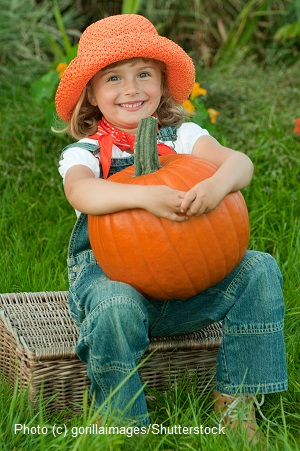The Year of the Pumpkin
 For many, pumpkins are associated with autumn, sweet desserts, and holiday festivities. But if you’re a gardener, spring is the time of year to start thinking about them. And this Spring is a particularly good time to begin, because the National Garden Bureau has declared this the Year of the Pumpkin. For many, pumpkins are associated with autumn, sweet desserts, and holiday festivities. But if you’re a gardener, spring is the time of year to start thinking about them. And this Spring is a particularly good time to begin, because the National Garden Bureau has declared this the Year of the Pumpkin.
Pumpkins and other crops in the Cucurbitaceae family originated in Central America, where strips of pumpkin flesh would be roasted and eaten, and the dried skins would be woven into mats. When European colonists arrived in the Americas, they prepared a dish believed to be a precursor of modern pumpkin pie. They cut the top off the pumpkin, removed the seeds, and filled the inside with milk, spices, and honey before baking it over hot ashes.
The popular tradition of pumpkin carving was derived from an Irish custom of carving jack-o’-lanterns out of turnips and potatoes, then placing an ember inside to ward off evil spirits. When Irish immigrants arrived in America in the 1800s, they brought this custom with them and applied it to pumpkins.
Today, pumpkins are a staple for fall decorations and recipes. Eating pumpkin provides numerous health benefits: they are high in fiber, potassium, iron, and vitamins A, B and C while being low in calories, fat, and sodium. Pumpkin is excellent in baked goods, soups, casseroles, pasta, and sauces. Cook with pumpkin throughout the year to support heart health and healthy blood pressure.
What is a Pumpkin?
As a member of the Cucurbitaceae family, pumpkins are related to squash, cucumbers, and melons. Most varieties that we classify as pumpkins belong to the species Cucurbita pepo, which also includes varieties of winter squash, summer squash, zucchini, and gourds. These pumpkins are characterized by round fruit with a thick shell that has smooth, slightly ribbed skin and a deep yellow to orange color.
Some winter squash varieties from the species Cucurbita maxima (Jarrahdale, Turk’s Turban, and all giant pumpkins) and Cucurbita moschata (Long Island Cheese, Rouge Vif D’Etampes) are sometimes also considered pumpkins due to their similar appearance.
The diversity among varieties that are classified as pumpkins is incredible! With sizes ranging from four ounces to over 1,000 pounds, various unique shapes, and brilliant colors like orange, yellow, white, green, blue, gray, pink, and tan, there are endless opportunities to select the perfect pumpkin.
Choosing the Perfect Pumpkin
When selecting a pumpkin for cooking, it is best to choose a “pie pumpkin” which has dense, sweet flesh. Pik-A-Pie is a go-to favorite. The sugars and lower moisture of these types hold up best in cooking. It is also easy to grow pumpkins for harvesting edible seeds. To save time, choose a naked-seeded (hull-less or semi hull-less) pumpkin with seeds that do not need to be hulled before eating. The variety Naked Bear is an excellent all-around choice for cooking, edible seeds, and making pumpkin seed oil. Pepitas, an AAS Winner, has a strong handle, beautiful golden orange rinds with dark green streaks. The pumpkin is delicious, with nutritious flesh and bountiful “naked” tender, succulent, nutty seeds for roasting.
When selecting pumpkins for carving and fall decoration, choose varieties that suit your style. Traditional carving pumpkins are medium to large in size, deep orange, and lightly ribbed with a strong handle. Some standards are Gladiator, Magic Lantern, and Howden. If you’d like to get creative with your carving, try a warted, yellow, or white pumpkin. For painting, look for a small pumpkin with a strong handle and a smooth surface.
Add additional interest to fall decor using miniature pumpkins with unique colors and patterns. Miniature pumpkins are typically less than two pounds and can be found in a variety of shapes and colors.
How to Grow Pumpkins
To have mature pumpkins for use in autumn, plant seeds between late May and mid-June after all risk of frost has passed. Seeds can be direct sown or started indoors and should be planted at a depth of one inch into well-drained soil that has warmed to 21°C (70°F). To ensure fruit set and yields, allow sufficient space between each plant: Give small pumpkins a 12-foot area, large pumpkins a 24-foot area, and giant pumpkins a 36- to 48-foot area per plant.
Pumpkins perform best when they are fertilized throughout the growing season and fruit set will be strongest if the flowers are pollinated by bees. If pumpkin flowers are not pollinated completely, the fruit will start growing but will abort before full development. To ensure a bountiful pumpkin harvest, encourage bees in your garden or pollinate the flowers by hand.
When the pumpkins have matured, the stem holding the fruit will begin to dry. Harvest the pumpkin by carefully cutting the vine on each side of the fruit stem, leaving a nub at the point where the stem meets the vine. This will encourage the stem to maintain strength as it dries down and will minimize infection by microbes that can cause decay.
To keep longer-lasting pumpkins, wash them, allow to dry, and place in a cool, shady spot after harvest. Then they’ll be ready to carve, decorate, or use in the kitchen.
The uses of beautiful, versatile fruits in the garden and kitchen are limitless, so let your creativity bloom!
Click here for some delicious pumpkin recipes. Thanks to the National Garden Bureau for its contributions to this article.
|

